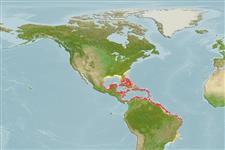Environment / Climate / Range
Ecology
Marine; brackish; demersal; depth range ? - 60 m (Ref. 13608). Tropical, preferred ?
Western Atlantic: Tobago to São Paulo, Brazil (Ref. 57756).
Size / Weight / Age
Maturity: Lm ? range ? - ? cm
Max length : 14.0 cm SL male/unsexed; (Ref. 13608)
Dorsal
spines
(total): 2;
Dorsal
soft rays
(total): 20-29;
Anal
spines: 0;
Anal
soft rays: 19. All fin membranes brownish proximally, blackish from medial to distally, white extremely; body dark brown; diffuse black saddle-shaped blotches on body, 1 on orbital region and dorsal spine area, 3 on soft dorsal; no black spot except for base of dorsal and opercular spines (Ref. 13608).
Numerous in the estuarine areas of the Brazilian coast; stays motionless in the sandy or muddy bottoms; the venom is injected in the flesh of the victim when pressure is applied on the gland (Ref. 55461).
Life cycle and mating behavior
Maturity | Reproduction | Spawning | Eggs | Fecundity | Larvae
Collette, B.B., 1966. A review of the venomous toadfishes, subfamily Thalassophryninae. Copeia 1966(4):846-864. (Ref. 30721)
IUCN Red List Status (Ref. 115185)
CITES (Ref. 94142)
Not Evaluated
Human uses
More information
Common namesSynonymsMetabolismPredatorsEcotoxicologyReproductionMaturitySpawningFecundityEggsEgg development
Age/SizeGrowthLength-weightLength-lengthLength-frequenciesMorphometricsMorphologyLarvaeLarval dynamicsRecruitmentAbundance
ReferencesAquacultureAquaculture profileStrainsGeneticsAllele frequenciesHeritabilityDiseasesProcessingMass conversion
Tools
Special reports
Download XML
Internet sources
Estimates of some properties based on models
Phylogenetic diversity index (Ref.
82805): PD
50 = 0.5156 [Uniqueness, from 0.5 = low to 2.0 = high].
Bayesian length-weight: a=0.00389 (0.00180 - 0.00842), b=3.12 (2.94 - 3.30), in cm Total Length, based on all LWR estimates for this body shape (Ref.
93245).
Trophic Level (Ref.
69278): 3.5 ±0.5 se; Based on size and trophs of closest relatives
Resilience (Ref.
69278): Medium, minimum population doubling time 1.4 - 4.4 years (Preliminary K or Fecundity.).
Vulnerability (Ref.
59153): Low to moderate vulnerability (34 of 100) .
